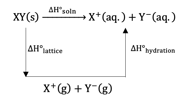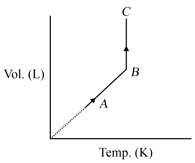Enthalpies for Different Types of Reactions
Enthalpies for Different Types of Reactions: Overview
In this topic, we will study the detailed explanation of standard enthalpy of combustion and enthalpy of atomization. It also explains bond enthalpy, lattice enthalpy, enthalpy of solution and enthalpy of dilution.
Important Questions on Enthalpies for Different Types of Reactions
What is the enthalpy change for,
if heat of formation of are and respectively (in standard conditions)?
The enthalpy changes at in successive breaking of bonds of water are-
The bond enthalpy of bond is
The enthalpy change that accompanies melting of one mole of a solid substance in standard state is called enthalpy of atomization.
What is the difference between heat of solution and heat of dilution?
The integral heat of dilution is viewed on a macro scale.
The _____ heat/enthalpy of dilution is viewed on a micro scale.
The lattice enthalpy and hydration enthalpy of four compounds are given below:
| Compounds | Lattice enthalpy | Hydration enthalpy |
| (in ) | (in ) | |
The pair of compounds which is soluble in water is
The amount of energy released in burning of coal is
Match the column I with column II and mark the appropriate choice.
| Column - I | Column - II | ||
|---|---|---|---|
Define and explain enthalpy of atomization with an example.
Calculate the enthalpy change for the reaction,
and hence, calculate the bond enthalpy of
bond in from the following data;
where is the enthalpy of atomization.
Given,
What is the standard enthalpy of formation of NH3 gas in KJ mole-1.
Which of the following is not a correct statement about enthalpy of solution?
Study the figure given below and mark the correct expression.

The enthalpy of solution of In water can be determined by
for the reaction,
( of , , and are and respectively)
For the reaction, . Bond energy of , then calculate the average bond energy of bond using the above data (Give the nearest integer answer, in )
A triatomic linear (neglect vibration degree of freedom) gas of two moles is taken through a reversible process, ideally starting from A as shown in figure.
The volume ratio . If the temperature at A is :

Total enthalpy change in both steps in cal/mol is :
If the bond energies of respectively, the for the reaction is
500 ml of 1 M HCN is neutralized completely by 500 ml of 1 M KOH solution and 1.36 K.cal of heat is liberated. The of dissociation of HCN is
What is the bond enthalpy of Xe - F bond if Ionization energy of , electron affinity of
